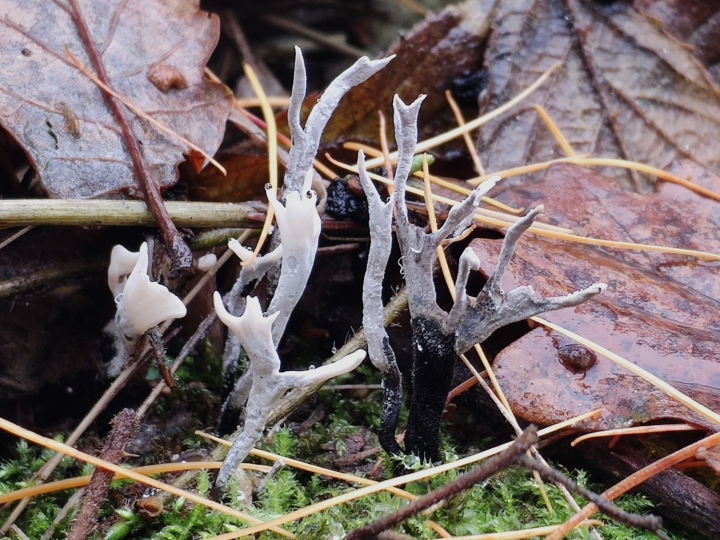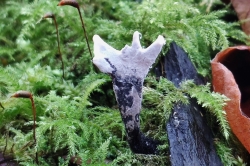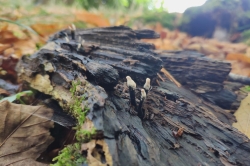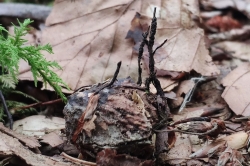A beautiful and fragile-looking mushroom, which looks like dancing ghosts of the forest, or the antlers of tiny stags…
Home / Mushroom Guide /
Candlesnuff Fungus
Candlesnuff Fungus
| Mushroom Type | |
| Common Names |
Candlesnuff Fungus, Cyrn Gwyn (CY), Próchnilec Gałęzisty (PL), Szarvas Agancsgomba (HU) |
| Scientific Name |
Xylaria hypoxylon |
| Synonyms |
Cordyceps hypoxylon, Sphaeria hypoxylon, Clavaria hypoxylon |
| Season Start |
All |
| Season End |
All |
| Average Mushroom height (CM) |
5-8 |
| Average Cap width (CM) |
Please note that each and every mushroom you come across may vary in appearance to these photos.
Fruiting Body
What we can see is not the fruit body of the species, but a communal fruit body (called a stroma). It hosts hundreds of individual fruit bodies.
The stroma is really variable by shape and size, it could be 7–8 cm tall and 1–3 cm wide. It is upright, compressed, needle-like to more or less branching, like a stag’s antler, (hence the common English name). It is initially greyish, covered with fine white-grey dust (conidia), turning dark, almost black with maturation. The stroma’s surface is covered with black, sub-spherical, pimple-like tiny fruit bodies (called perithecia) which can hardly be detected by the naked eye. The lower, sterile, stem-like supportive part of the stroma is black and more or less hairy.
Flesh
Really thin, white and more or less tough.
Habitat
Saprotrophic on dead wood of deciduous trees, including fallen branches, and occasionally can be seen on conifer stumps too. Might be acting as weak parasite on ailing, injured or stressed trees. It is a really common species in any sort of woodlands, urban parks, etc.
Possible Confusion
It is really hard to confuse with anything else, but some authors says it might or could be confused with Beechmast Candlesnuff (Xylaria carpophila), pictured, so let’s look at the difference between these two species:
Candlesnuff Fungus is growing on the dead wood of hardwood trees, (also, rarely, on heavily decayed conifer stumps), while Beechmast Candlesnuff is growing on decaying beechmast.
Candlesnuff Fungus forks like the antler of a stag, while Beechmast Candlesnuff is not forked at all.
Taste / Smell
Inedible. Smell and taste not distinctive.
Frequency
Common and widespread.
Spores
Spore print is black. Sexual spores are produced by the asci (singular: ascus), hence called ascospores. Bean-shaped, some might be flattened on one side, smooth, dark brown with 1–2 oil-droplets (guttule) when young.
Asexual spores (conidiospores) are smaller than sexual spores; they are smooth, ellipsoidal and colourless (hyaline).
Other Facts
The species is a subject of pharmacological researches. Some of its biologically active compounds, such as xylarial A and B showed moderate cytotoxic activity against human hepatocellular carcinoma cells (HepG2). Its pyrone-derivatives, (such as xylarone and 8,9-dehydroxylarone), which were isolated from the submerged culture of X. hypoxylon strain A27-94, showed cytotoxic activity against various cancer cell-lines in vitro.



























Leave a Reply